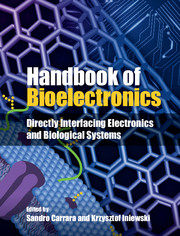Book contents
- Frontmatter
- Contents
- List of Contributors
- 1 What is bioelectronics?
- Part I Electronic components
- Part II Biosensors
- 8 Introduction to biosensors
- 9 CNT and proteins for bioelectronics in personalized medicine
- 10 CMOS nanowire biosensing systems
- 11 Cell-array biosensors
- 12 System-on-a-chip pulse radar for contactless motion sensing in human–machine smart interfaces
- 13 MagCMOS
- 14 Metamorphic neural interfaces with insects for remote controlled biobots
- Part III Fuel cells
- Part IV Biomimetic systems
- Part V Bionics
- Part VI Brain interfaces
- Part VII Lab-on-a-chip
- Part VIII Future perspectives
- Index
- References
12 - System-on-a-chip pulse radar for contactless motion sensing inhuman–machine smart interfaces
from Part II - Biosensors
Published online by Cambridge University Press: 05 September 2015
- Frontmatter
- Contents
- List of Contributors
- 1 What is bioelectronics?
- Part I Electronic components
- Part II Biosensors
- 8 Introduction to biosensors
- 9 CNT and proteins for bioelectronics in personalized medicine
- 10 CMOS nanowire biosensing systems
- 11 Cell-array biosensors
- 12 System-on-a-chip pulse radar for contactless motion sensing in human–machine smart interfaces
- 13 MagCMOS
- 14 Metamorphic neural interfaces with insects for remote controlled biobots
- Part III Fuel cells
- Part IV Biomimetic systems
- Part V Bionics
- Part VI Brain interfaces
- Part VII Lab-on-a-chip
- Part VIII Future perspectives
- Index
- References
Summary
The rapid evolution of micro-nanoelectronics has led to unprecedentedopportunities to implement ultra-miniaturized electronic systems anddirectly interface them with biological systems. Thanks to the hugepossibilities in terms of design space, nanoscale microelectronic circuitscan allow the implementation of incredibly compact electronic systems withvery complex functionalities, including sensing, actuating, processing, andcommunicating, which could be potentially employed in countless newopportunities to realize “smart” (i.e. able to perform complexfunctions) human–machine interfaces in both directions, from human tomachine (including also humanoid robots) and vice versa, and so closing theinformation loop in order to allow bidirectional interactions. However, theencumbrance of the contact-based interfaces could greatly limit theexploitation of the emerging plethora of potential opportunities to buildsmart human–machine interfaces. To overcome these limitations, thereis growing interest in autonomous electronic systems that, in general, couldbe expected to be contactless, self- or remotely powered,ultra-miniaturized, non- or minimally invasive with negligible side effects,biocompatible, eco-friendly (i.e. green), low-cost, and so on, that we couldrefer to as zero-power [1] and more generally aszero-impact electronic systems, sometimes also referredto as “smart dust” [2]. These future and emerging technologiesare an extremely active macro-area of research [3] that, in spite ofenormous recent progress, is still at the early stage. In this generalcontext of grand challenges, the current silicon-based microelectronictechnologies can provide a huge range of opportunities for deliveringpotential solutions that could respond, at least in part, to the wishfulthinking for the most effective solutions of the future.
Information
- Type
- Chapter
- Information
- Handbook of BioelectronicsDirectly Interfacing Electronics and Biological Systems, pp. 155 - 169Publisher: Cambridge University PressPrint publication year: 2015
